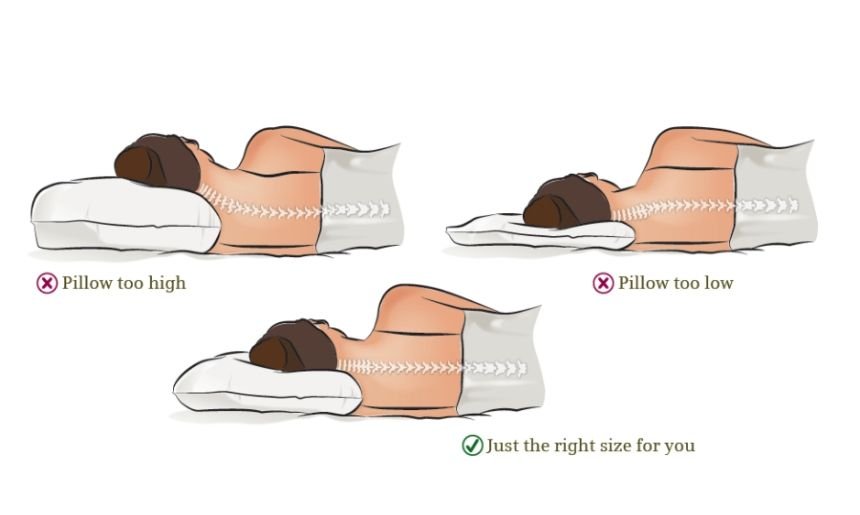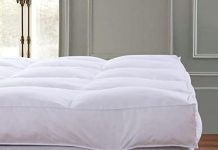Are you tired of waking up with a stiff neck or nagging back pain? If so, you might want to take a closer look at what you rest your head on each night. Surprisingly, your pillow could be playing a significant role in your discomfort. Many people underestimate the influence a pillow can have on our sleep quality and overall well-being. From offering proper support to aligning the spine, the right pillow can make all the difference in reducing both neck and back pain. So, before you dismiss that pillow as just a cozy accessory, let’s explore how it can impact your daily life and how to choose the best pillow for your needs.
Review contents
The Relationship Between Pillow and Neck and Back Pain
Anatomy of the Neck and Back
To understand the relationship between pillows and neck and back pain, it is important to have a basic understanding of the anatomy of these areas. The neck consists of seven vertebrae, known as the cervical spine, which provides support and mobility to the head. The back, on the other hand, is composed of the spinal column, which includes the thoracic spine (middle back) and the lumbar spine (lower back). Muscles, ligaments, and tendons surround and support these structures, allowing for movement and stability.
Causes of Neck and Back Pain
Neck and back pain can have various causes, ranging from muscular strains to underlying medical conditions. Poor posture, such as slouching or sitting for extended periods, can put strain on the neck and back muscles, leading to discomfort and pain. Injury or trauma, such as whiplash from a car accident, can also result in neck and back pain. Additionally, degenerative conditions like arthritis or herniated discs can contribute to chronic neck and back pain.
The Role of Pillow in Neck and Back Pain
The choice of pillow plays a crucial role in maintaining proper alignment of the neck and spine. A well-designed pillow provides support to these areas, allowing the muscles and ligaments to relax and recover during sleep. On the other hand, an incorrect pillow can disrupt the natural curvature of the spine, leading to misalignment and increased tension on the muscles and joints. This misalignment can result in neck and back pain upon waking up or exacerbate existing pain throughout the day.
Choosing the Right Pillow
Understanding Different Pillow Types
When it comes to choosing the right pillow for neck and back pain, it is essential to consider the different types available. Memory foam pillows, for example, conform to the shape of the head and neck, providing customized support. Cervical pillows have a contoured design that cradles the neck, promoting proper alignment. Water pillows allow for customizable firmness, while microbead pillows offer a soft and supportive alternative.
Considerations for Pillow Selection
When selecting a pillow, several factors come into play. The size and shape of the pillow should align with the individual’s sleeping position and body size. Back sleepers may benefit from a thinner pillow that provides adequate support without lifting the head too high, while side sleepers may require a thicker pillow to keep the spine properly aligned. Stomach sleepers may find a flatter pillow more comfortable to prevent strain on the neck.
Pillow Firmness and Support
The firmness of a pillow is another crucial factor to consider. The pillow should be firm enough to support the natural curvature of the neck and spine, but not so firm that it causes discomfort. It should strike a balance between providing support and allowing the muscles and joints to relax. Ultimately, the optimal firmness varies for each individual, and personal preference plays a significant role in determining comfort.
Pillow Material and Allergies
Pillow material can also impact neck and back pain, particularly for individuals with allergies. Hypoallergenic materials, such as cotton or bamboo, are ideal for those prone to allergies or respiratory issues. Additionally, some pillows come with antimicrobial properties that prevent the buildup of allergens and dust mites, ensuring a clean and healthy sleep environment.
This image is property of embed.widencdn.net.
Effects of Incorrect Pillow on Neck and Back Pain
Alignment Issues
One of the primary effects of using an incorrect pillow is the misalignment of the neck and spine. When the pillow fails to adequately support the natural curvature of these areas, the muscles and ligaments can become strained and tense. This misalignment can lead to discomfort, stiffness, and even more severe neck and back pain over time.
Strain on Muscles and Joints
An unsuitable pillow can put unnecessary strain on the muscles and joints of the neck and back. For example, a pillow that is too flat may cause the head to tilt forward, straining the muscles at the back of the neck. Similarly, a pillow that is too thick or firm can elevate the head and cause excessive pressure on the neck and spine, leading to muscle tension and discomfort.
Reduced Blood Circulation
Using an incorrect pillow can also affect blood circulation. When the neck and spine are misaligned, the blood vessels and nerves in these areas can become compressed or restricted, impairing blood flow. Inadequate blood circulation can contribute to muscle stiffness, numbness, and an overall decrease in oxygen supply to the affected tissues, potentially exacerbating neck and back pain.
The Importance of Proper Pillow Placement
Optimal Sleeping Positions
In addition to choosing the right pillow, proper pillow placement is essential for maintaining a healthy neck and back. The ideal sleeping position varies depending on individual preference and comfort, but there are a few general guidelines to follow. For back sleepers, placing a pillow under the knees can help alleviate pressure on the back and promote a neutral spinal alignment. For side sleepers, placing a pillow between the knees can help maintain proper hip and spine alignment. Stomach sleepers may benefit from using a thin pillow or not using a pillow at all to prevent excessive strain on the neck.
Using Pillows for Support
Pillows can be utilized for additional support in various areas of the body, further promoting optimal alignment. For example, placing a small pillow or rolled-up towel under the small of the back can provide lumbar support for those who experience lower back pain. Similarly, placing a pillow under the arm or between the elbows can prevent shoulder and neck strain for side sleepers.
Elevating Legs and Spine
In some cases, elevating the legs and spine with the help of pillows can provide relief from neck and back pain. For individuals with lower back pain, placing a pillow under the knees while lying on the back can help alleviate pressure on the lumbar spine. Elevating the legs with a pillow while lying on the back can also promote better blood circulation and reduce strain on the lower back. Additionally, using a wedge-shaped pillow to elevate the upper body can assist individuals with acid reflux or breathing difficulties during sleep.
This image is property of osteopathyinharrogate.co.uk.
Recommended Pillows for Neck and Back Pain Relief
Contoured Memory Foam Pillows
Contoured memory foam pillows are designed to cradle and support the head and neck, promoting proper alignment and relieving neck and back pain. These pillows mold to the individual’s shape, providing customized support and minimizing pressure points. The ergonomic design of contoured memory foam pillows helps maintain the natural curvature of the neck and spine, ensuring a restful and pain-free sleep.
Cervical Pillows
Cervical pillows, also known as neck support pillows, have a unique contour that supports the natural curve of the neck. These pillows are often recommended for individuals who suffer from chronic neck pain or have neck-related conditions. The contoured shape of cervical pillows helps align the spine, relieving stress on the neck and upper back muscles. By promoting proper posture during sleep, cervical pillows can significantly reduce neck and back pain.
Water Pillows
Water pillows offer customizable firmness and support, making them suitable for individuals with varying preferences or specific neck and back pain issues. These pillows contain a water chamber that can be adjusted to achieve the desired level of firmness or softness. The water inside the pillow molds to the contours of the head and neck, providing optimal support while reducing pressure points. Water pillows also allow for easy adjustment throughout the night, ensuring maximum comfort.
Microbead Pillows
Microbead pillows are filled with tiny polystyrene beads that conform to the shape of the head and neck. These pillows offer a soft and supportive option for individuals with neck and back pain. The microbead filling allows for more flexibility and adaptability than traditional pillow fillings, ensuring proper alignment and pressure relief. Microbead pillows provide gentle support, making them suitable for individuals who prefer a softer pillow surface.
Sleeping Habits and Lifestyle Factors
Sleeping Positions and Neck/Back Pain
In addition to pillow selection, an individual’s sleeping position can significantly impact neck and back pain. While it may be challenging to control sleeping positions throughout the night, awareness of the optimal positions can help. Back sleeping is generally considered the best position for promoting spinal alignment, as it allows the head, neck, and spine to rest in a neutral position. Side sleeping with proper support between the legs can also help maintain proper alignment. Stomach sleeping, however, can strain the neck and back, as it often requires the head to be turned to the side for breathing, causing misalignment.
The Effect of Mattress on Pillow Performance
The mattress that one sleeps on can also affect the performance of the pillow in providing neck and back pain relief. An overly firm or sagging mattress may not provide adequate support, causing the pillow’s benefits to be limited. It is essential to choose a mattress that complements the support provided by the pillow, ensuring a balanced and comfortable sleeping surface. Consulting with a healthcare professional or mattress specialist can help identify the best mattress for individual needs and preferences.
The Impact of Exercise and Ergonomics
Regular exercise and ergonomics play a crucial role in maintaining a healthy neck and back. Strengthening and stretching exercises can help improve muscle tone, flexibility, and posture, reducing the likelihood of experiencing neck and back pain. Additionally, practicing good ergonomics in daily activities, such as maintaining proper posture while sitting at a desk or lifting heavy objects correctly, can minimize strain on the neck and back. By incorporating exercise and ergonomics into daily routines, individuals can support the effects of a suitable pillow for neck and back pain relief.
This image is property of media.cnn.com.
Tips for Maintaining a Healthy Spine
Stretching and Strengthening Exercises
Engaging in regular stretching and strengthening exercises can help maintain a healthy spine and reduce the risk of neck and back pain. Exercises that target the neck, back, and core muscles can improve flexibility, posture, and overall spinal health. Standard exercises like yoga or Pilates are excellent choices for enhancing spinal strength and maintaining proper alignment. It is essential to consult with a healthcare professional or a certified trainer to determine the most suitable exercises for individual needs and to ensure proper form during the exercises.
Proper Posture and Body Mechanics
Maintaining proper posture throughout the day is essential for preserving spinal health and preventing neck and back pain. Whether standing, sitting, or lifting, it is important to maintain a neutral spine position, with the shoulders back and the head aligned with the body. Slouching or hunching over can strain the muscles and ligaments of the back and neck, increasing the risk of pain and discomfort. Practicing good body mechanics when performing daily activities, such as lifting heavy objects using the legs instead of the back, can further protect the spine from unnecessary strain.
Avoiding Excessive Smartphone and Computer Use
The increasing reliance on smartphones and computers in our daily lives can contribute to neck and back pain, often referred to as “text neck” or “tech neck.” Spending extended periods with the head tilted forward to view screens can strain the muscles and ligaments of the neck and upper back. To minimize the risk of developing neck and back pain, it is important to take regular breaks, practice good posture while using devices, and hold devices at eye level to reduce strain on the neck and spine. Maintaining awareness and implementing healthy smartphone and computer habits is crucial for maintaining a healthy spine.
Consulting a Healthcare Professional
When to Seek Medical Advice
While proper pillow selection and sleeping habits can alleviate minor neck and back pain, there are instances where medical advice should be sought. If the pain persists or worsens despite using suitable pillows and following recommended practices, it is crucial to consult with a healthcare professional. Additionally, if the pain is accompanied by other symptoms, such as numbness, weakness, or radiating pain down the arms or legs, immediate medical attention should be sought to rule out underlying medical conditions.
Physical Therapy and Chiropractic Care
Healthcare professionals such as physical therapists and chiropractors can play a crucial role in addressing neck and back pain. Physical therapy can help strengthen and rehabilitate the muscles and improve overall spinal health. Chiropractic care focuses on spinal adjustments to restore proper alignment and alleviate pain. These professionals can provide tailored treatment plans, including exercises, manual therapy, and postural correction techniques, to address the underlying causes of neck and back pain and promote long-term relief.
Alternative Therapies for Pain Relief
In addition to traditional medical approaches, there are alternative therapies that individuals may consider for neck and back pain relief. These may include acupuncture, massage therapy, or even herbal remedies. While the efficacy of these treatments varies and may not be suitable for everyone, some individuals find them beneficial in reducing pain and promoting relaxation. It is important to consult with a qualified practitioner before trying any alternative therapies and to integrate them into an overall comprehensive treatment plan.
This image is property of quiropracticagandi.com.
Conclusion
The relationship between pillows and neck and back pain is a significant one. Choosing the right pillow and using it in conjunction with proper sleeping positions and pillow placement can greatly alleviate discomfort and promote spinal health. Investing in a pillow that provides adequate support and aligns with individual needs and preferences is essential for reducing strain on the neck and back muscles. Maintaining a healthy spine goes beyond pillow selection; incorporating lifestyle factors such as exercise, ergonomics, and postural awareness also play a significant role. If neck and back pain persist or worsen, consulting a healthcare professional is crucial to determine underlying causes and develop an appropriate treatment plan. By prioritizing spinal health and making informed choices, individuals can experience relief from neck and back pain, allowing for a restful and rejuvenating sleep experience.




























